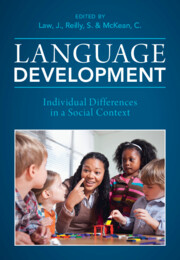Book contents
- Language Development
- Language Development
- Copyright page
- Contents
- Figures
- Tables
- Contributors
- A Tribute to Our Friend, Colleague and Fellow Editor, Professor James Law
- Introduction
- 1 Language Development
- 2 Social Contexts and Language Development
- Part One Factors Influencing Language Development
- Part Two Continuity and Change
- Part Three Impact, Intervention and Equity
- Index
- References
2 - Social Contexts and Language Development
Past, Present and Future
from Introduction
Published online by Cambridge University Press: 11 August 2022
- Language Development
- Language Development
- Copyright page
- Contents
- Figures
- Tables
- Contributors
- A Tribute to Our Friend, Colleague and Fellow Editor, Professor James Law
- Introduction
- 1 Language Development
- 2 Social Contexts and Language Development
- Part One Factors Influencing Language Development
- Part Two Continuity and Change
- Part Three Impact, Intervention and Equity
- Index
- References
Summary
The acquisition of language is a human universal, achieved by all normal children raised in normal environments. However, normal environments vary widely, with consequences for children’s language development. This chapter introduces the subsequent chapters in this edited volume, providing historical background and presenting findings from two contemporary research projects. The historical background includes shifts in the field of language acquisition from linguistics to a bioecological model of development as the guiding theoretical framework, shifts from universals of language acquisition to individual differences as the outcome to be explained, and multiple methodological advances that have made possible much of the research presented in this book. The current empirical work presented in this chapter includes one project on language development in the bilingual context of immigrant families in the United States and another project on home and childcare influences on the language and preliteracy skill development of children in Denmark, in the context of near-universal childcare attendance.
Keywords
- Type
- Chapter
- Information
- Language DevelopmentIndividual Differences in a Social Context, pp. 23 - 40Publisher: Cambridge University PressPrint publication year: 2022
References
- 3
- Cited by

